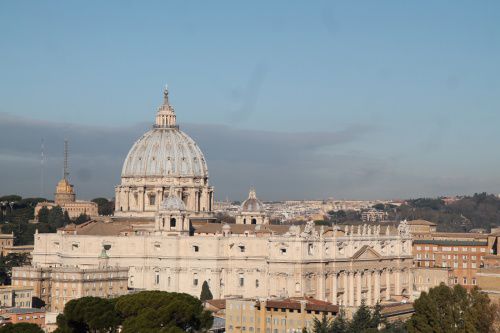This week the U.S. Embassy to the Holy See has begun its move to a new building — which shares the same campus as both the U.S. Embassy to Italy and the U.S. Mission to the United Nations. “We are looking forward to a larger, more modern facility that can provide a more functional space for our staff,” U.S. ambassador Ken Hackett said in an Aug. 11 statement announcing the move. He said the Unites States’ relationship with the Holy See “is important and continues to grow as we work together to promote human rights, social justice and peace around the world,” adding that the new facility provides “a more robust workspace” to carry out their ongoing collaboration with the Vatican and with the Catholic humanitarian and academic communities in Rome. “We will have greater space for the future possibility of staff increases, and we will have a significant increase in space to host visitors for meetings and events.” Although the new building will be on the same property as the other two U.S. missions in Rome, it will have a separate space and entrance. The embassy is set to open its new facility Aug. 17. The new chancery building will be officially inaugurated in early September, and high-ranking U.S. Department of State and Holy See officials are expected to be present. Antoinette Hurtado, Public Affairs Officer for the U.S. Embassy to the Holy See, told CNA Aug. 11 that she is excited for the move “because our new facility is really a substantial increase in size and quality.” “It’s more modern and functional while also retaining the artistic and historic aspects of the renovated 1920s building we are moving into,” she said. With several large conference rooms as opposed to the small space used in the previous building, the embassy will “finally have the space to host visitors and colleagues for conferences and meetings,” she added. The new building was recently renovated in order to be more environmentally-friendly, and is equipped with upgrades designed to conserve resources and cut operating costs. It is also the first U.S. diplomatic building to receive a certification in Leadership in Energy and Environmental Design in the Existing Buildings: Operations and Maintenance category. Although the relocation of the U.S. Embassy to the Holy See is being welcomed by current staff, it hasn’t always been received with such enthusiasm. In 2013 previous U.S. ambassadors criticized the decision, saying the move would diminish the embassy’s influence. Former U.S. ambassador to the Holy See James Nicholson told CatholicVote.org in 2013 that the embassy’s planned move to the grounds of the U.S. Embassy to Italy is “another manifestation of the antipathy of this administration both to Catholics and to the Vatican — and to Christians in the Middle East.” “This is a key post for intermediation in so many sovereignties but particularly in the Middle East,” Nicholson said. “This is anything but a good time to diminish the stature of this post. To diminish the stature of this post is to diminish its influence.” The U.S. did not establish full diplomatic relations with the Vatican until 1984, in part because of anti-Catholic sentiment. Criticism was also voiced by former U.S. ambassadors Francis Rooney, Mary Ann Glendon, Raymond Flynn and Thomas Melady. However, State Department officials defended the decision as good for security, and Nicole Thompson of the State Department’s press relations office cited security as the primary motive for the move. Security was reviewed after an attack on a U.S. diplomatic post in Benghazi, Libya, killed the U.S. ambassador to the country. Thompson also said the move will save on operating costs. “We reject any suggestion that this decision, made for security and administrative reasons, constitutes a downgrading of our relations with the Holy See,” she said. Despite the previous controversy, the Aug. 11 statement on the move holds that the relocation fulfills the U.S. Department of State security’s recommendations, specifically their call for U.S. government facilities to be collocated when located in the same metropolitan area. It is also said the embassy’s long-term costs will diminish, since they won’t be paying lease charges for the current building.

